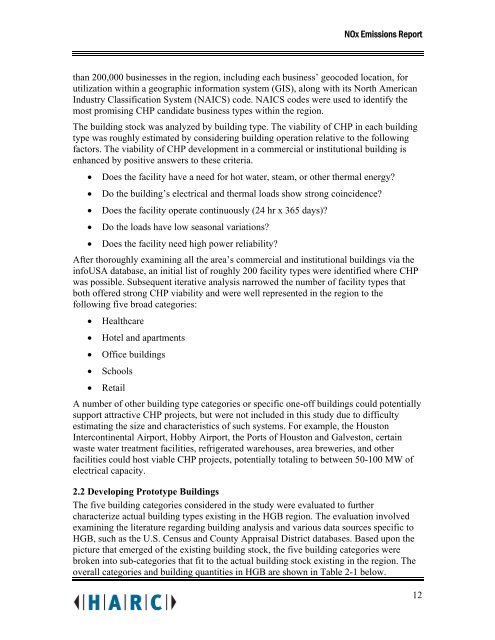NOx Emissions Impacts from Widespread Deployment of CHP in ...
NOx Emissions Impacts from Widespread Deployment of CHP in ...
NOx Emissions Impacts from Widespread Deployment of CHP in ...
You also want an ePaper? Increase the reach of your titles
YUMPU automatically turns print PDFs into web optimized ePapers that Google loves.
<strong>NOx</strong> <strong>Emissions</strong> Report<br />
than 200,000 bus<strong>in</strong>esses <strong>in</strong> the region, <strong>in</strong>clud<strong>in</strong>g each bus<strong>in</strong>ess’ geocoded location, for<br />
utilization with<strong>in</strong> a geographic <strong>in</strong>formation system (GIS), along with its North American<br />
Industry Classification System (NAICS) code. NAICS codes were used to identify the<br />
most promis<strong>in</strong>g <strong>CHP</strong> candidate bus<strong>in</strong>ess types with<strong>in</strong> the region.<br />
The build<strong>in</strong>g stock was analyzed by build<strong>in</strong>g type. The viability <strong>of</strong> <strong>CHP</strong> <strong>in</strong> each build<strong>in</strong>g<br />
type was roughly estimated by consider<strong>in</strong>g build<strong>in</strong>g operation relative to the follow<strong>in</strong>g<br />
factors. The viability <strong>of</strong> <strong>CHP</strong> development <strong>in</strong> a commercial or <strong>in</strong>stitutional build<strong>in</strong>g is<br />
enhanced by positive answers to these criteria.<br />
• Does the facility have a need for hot water, steam, or other thermal energy?<br />
• Do the build<strong>in</strong>g’s electrical and thermal loads show strong co<strong>in</strong>cidence?<br />
• Does the facility operate cont<strong>in</strong>uously (24 hr x 365 days)?<br />
• Do the loads have low seasonal variations?<br />
• Does the facility need high power reliability?<br />
After thoroughly exam<strong>in</strong><strong>in</strong>g all the area’s commercial and <strong>in</strong>stitutional build<strong>in</strong>gs via the<br />
<strong>in</strong>foUSA database, an <strong>in</strong>itial list <strong>of</strong> roughly 200 facility types were identified where <strong>CHP</strong><br />
was possible. Subsequent iterative analysis narrowed the number <strong>of</strong> facility types that<br />
both <strong>of</strong>fered strong <strong>CHP</strong> viability and were well represented <strong>in</strong> the region to the<br />
follow<strong>in</strong>g five broad categories:<br />
• Healthcare<br />
• Hotel and apartments<br />
• Office build<strong>in</strong>gs<br />
• Schools<br />
• Retail<br />
A number <strong>of</strong> other build<strong>in</strong>g type categories or specific one-<strong>of</strong>f build<strong>in</strong>gs could potentially<br />
support attractive <strong>CHP</strong> projects, but were not <strong>in</strong>cluded <strong>in</strong> this study due to difficulty<br />
estimat<strong>in</strong>g the size and characteristics <strong>of</strong> such systems. For example, the Houston<br />
Intercont<strong>in</strong>ental Airport, Hobby Airport, the Ports <strong>of</strong> Houston and Galveston, certa<strong>in</strong><br />
waste water treatment facilities, refrigerated warehouses, area breweries, and other<br />
facilities could host viable <strong>CHP</strong> projects, potentially total<strong>in</strong>g to between 50-100 MW <strong>of</strong><br />
electrical capacity.<br />
2.2 Develop<strong>in</strong>g Prototype Build<strong>in</strong>gs<br />
The five build<strong>in</strong>g categories considered <strong>in</strong> the study were evaluated to further<br />
characterize actual build<strong>in</strong>g types exist<strong>in</strong>g <strong>in</strong> the HGB region. The evaluation <strong>in</strong>volved<br />
exam<strong>in</strong><strong>in</strong>g the literature regard<strong>in</strong>g build<strong>in</strong>g analysis and various data sources specific to<br />
HGB, such as the U.S. Census and County Appraisal District databases. Based upon the<br />
picture that emerged <strong>of</strong> the exist<strong>in</strong>g build<strong>in</strong>g stock, the five build<strong>in</strong>g categories were<br />
broken <strong>in</strong>to sub-categories that fit to the actual build<strong>in</strong>g stock exist<strong>in</strong>g <strong>in</strong> the region. The<br />
overall categories and build<strong>in</strong>g quantities <strong>in</strong> HGB are shown <strong>in</strong> Table 2-1 below.<br />
12
















